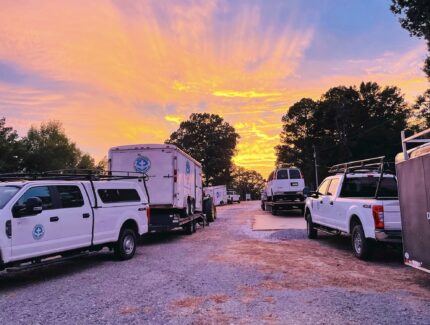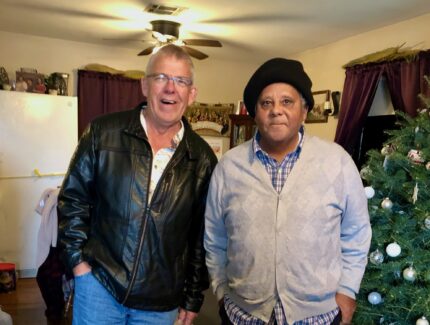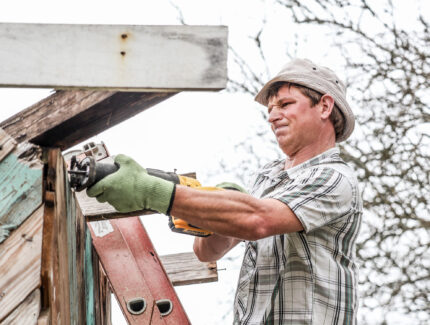


January 5, 2017
In Lafayette, who’s a “typical” disaster survivor?
Lafayette, LA — Mary George Ann Herbert Crupe is a nonconformist artist. She names her trees: the giant magnolia in her front yard is “Maggie,” the fig tree is (what else) “Figgie.” Her two dogs are Clateaux and Swiffer Sweeper (who goes by the name of “Mop”).
Crupe is no stranger to disasters. In 2002, Hurricane Lili nearly uprooted Maggie. “You won’t believe what I did,” Crupe says. “I took the tubes out of my kids’ bike tires and I shored up Maggie with them, right out there in the wind. The kids were upset, but I told them I’d get them new tires, that for now we had to save Maggie.”
Mary Crupe’s home was damaged in the 2016 floods. MDS volunteers are working on clean up and repair in the Lafayette, LA area. MDS Photo/Paul Hunt
Her four children grew up, Maggie survived, and Crupe is standing directly under the tree in her front yard in Lafayette to tell her story. Her house has been damaged by August 2016 flooding -but even before the disaster the house may have needed some work, she admits.
Mennonite Disaster Service (MDS) volunteers are working on the first level of the house, replacing drywall, repairing floors, even taking down a bees nest that has caused honey to cascade down one side wall.
The house is packed with furniture, dishes and whatnots shoved to one side or another while the work continues. “I play the ‘I Spy’ game trying to find stuff,” Crupe says, climbing the stairs to her room which is untouched by volunteers. Her walls are painted in bright colors and festooned with necklaces pinned up with small nails.
In Lafayette, Crupe is one of hundreds of people whose homes were deluged in August. Each has his or her own story. Many times, MDS volunteers have found themselves helping someone they find different than a “typical” disaster survivor they have either seen or imagined before.
The entire city of Lafayette has its own story about what it’s like to have “enough” and then, suddenly, to have much less. For decades, the city has been home to people employed by oil and gas companies: the energy sector and the manufacturers that support that sector.
Over their years of making a living, many people who were solidly “middle income” bought houses that weren’t in a flood zone, and raised their families. But 2016 brought more than floods: it was a year of job free-fall: 7,000 jobs in the city were eliminated in 2016 alone from the energy sector.
MDS volunteer Marcus Knepp measuring drywall at a project in Lafayette, LA. MDS Photo/Paul Hunt
People with middle-class homes were suddenly on zero income – then floods hit areas that have never been inundated before, and homes that never needed flood insurance in the first place.
Many people in so-called “middle class houses” are now piecing together their livelihoods best they can: through dabbling in the arts, or cooking, going back to college, switching job sectors – in many ways, going back to square one. Many who didn’t lose their jobs are now supporting family members who have.
Back downstairs, Crupe is showing off a wreath she has crafted from greens, berries and ribbons, asking if it’s as good as the wreaths you’d buy in a florist shop. “I also dabble with furniture, I redo chairs and tables, I write,” said Crupe, “and, yeah, boo, I’ve been through some disasters.”
“Boo” is a cajun term of endearment much like “honey” or “sweetheart” used with friends or family. She laughs, and goes on with her story: “And, I’ll tell you, when it comes to me, you can’t kill a bad weed, baby.”
Story by Susan Kim





